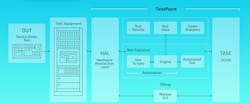HAL Simplifies Assembly of Automated Test Equipment
What you’ll learn:
- Why a hardware abstraction layer (HAL) facilitates building a test system.
- What does Testeract’s HAL look like?
- How developers can take advantage of Testeract’s TestPoint software.
Automated test systems rarely have a single input and output. They often need to deal with new sensors, control systems, and data-acquisition systems from a variety of sources. Integrating these into a cohesive automated test environment can be challenging if custom software and hardware is involved.
I talked with Jayson Wilkinson, Marketing Director at Testeract, about the company’s TestPoint test automation system (see figure) and how a hardware abstraction layer (HAL) is used to address the variety of test equipment on the market (watch the video above).
What is TestPoint?
TestPoint is a software system designed to support the creation and management of custom, automated test systems. Developers can leverage the TestPoint test framework to create test system configurations. The HAL is used to connect devices to TestPoint; the framework employs a test sequencer plugin like NI TestStand or OpenTAP, an open-source test sequencer originally developed by Keysight Technologies. The sequencer actually runs the tests that utilize the hardware devices connected to the test system.
The user interface for TestPoint is the Testeract Automated Systems Controller (TASC) (see the video below).
How the HAL Helps Develop Device Drivers
Dealing with a single source of data-acquisition and control systems tends to be the easiest way to go, like the suite of hardware and software available from Emerson’s Test and Measurement Group, formally NI/National Instruments. The challenge is that one company doesn’t have support for the plethora of new and custom devices that keep cropping up.
The HAL provides a way to develop device drivers for these new devices so that they can be incorporated into the test environment. It’s not a new approach, and the same method is applied to operating-system device drivers. Likewise, the creation of these standardized device drivers is typically accomplished by the device providers. Having a public HAL does make it easier to convince those to be provided. Likewise, writing a custom driver tends to be easier as well.
About the Author
William G. Wong
Senior Content Director - Electronic Design and Microwaves & RF
I am Editor of Electronic Design focusing on embedded, software, and systems. As Senior Content Director, I also manage Microwaves & RF and I work with a great team of editors to provide engineers, programmers, developers and technical managers with interesting and useful articles and videos on a regular basis. Check out our free newsletters to see the latest content.
You can send press releases for new products for possible coverage on the website. I am also interested in receiving contributed articles for publishing on our website. Use our template and send to me along with a signed release form.
Check out my blog, AltEmbedded on Electronic Design, as well as his latest articles on this site that are listed below.
You can visit my social media via these links:
- AltEmbedded on Electronic Design
- Bill Wong on Facebook
- @AltEmbedded on Twitter
- Bill Wong on LinkedIn
I earned a Bachelor of Electrical Engineering at the Georgia Institute of Technology and a Masters in Computer Science from Rutgers University. I still do a bit of programming using everything from C and C++ to Rust and Ada/SPARK. I do a bit of PHP programming for Drupal websites. I have posted a few Drupal modules.
I still get a hand on software and electronic hardware. Some of this can be found on our Kit Close-Up video series. You can also see me on many of our TechXchange Talk videos. I am interested in a range of projects from robotics to artificial intelligence.

